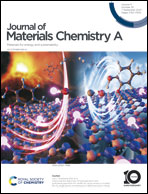A graphene aerogel with reversibly tunable thermal resistance for battery thermal management†
Abstract
Thermal management of electronic devices under extreme temperature conditions is very important. Carbon-based materials with low thermal resistance are beneficial for cooling electronic devices, while aerogels with high thermal resistance play a role in thermal insulation. However, achieving both thermal conduction and thermal insulation using the same material is a significant challenge. Herein, a graphene aerogel was synthesized by a solvothermal method, and the thermal resistance of the graphene aerogel was decreased by high-temperature annealing. The elastic graphene aerogel with tunable thermal resistance makes it possible to have dual functions of thermal insulation and thermal conduction. The thermal resistance of the graphene aerogel with 80% compressive strain is 3.3 times lower than that of the original state. During the process of thermal management for lithium-ion batteries (LIBs), the original graphene aerogel acts like a thermal insulator, preventing heat loss from LIBs when the ambient temperature is low (−20 °C), resulting in a temperature improvement of 9 °C and enhancing the discharge capacity of LIBs by 26%. In contrast, when the operating temperature is high (40 °C), the compressed graphene aerogel with low thermal resistance acts as a thermal interface material, dissipating the excessive heat from LIBs and preventing overheating.



 Please wait while we load your content...
Please wait while we load your content...